Key takeaways:
- Clear communication is essential to prevent misunderstandings and foster teamwork in virtual collaboration.
- Collaboration allows for diverse perspectives, leading to innovative solutions and preventing burnout by sharing the workload.
- Utilizing collaborative tools and maintaining a structured communication rhythm enhances team effectiveness and builds trust.
- Celebrating small wins and fostering inclusivity strengthens bonds and encourages team members to share ideas openly.
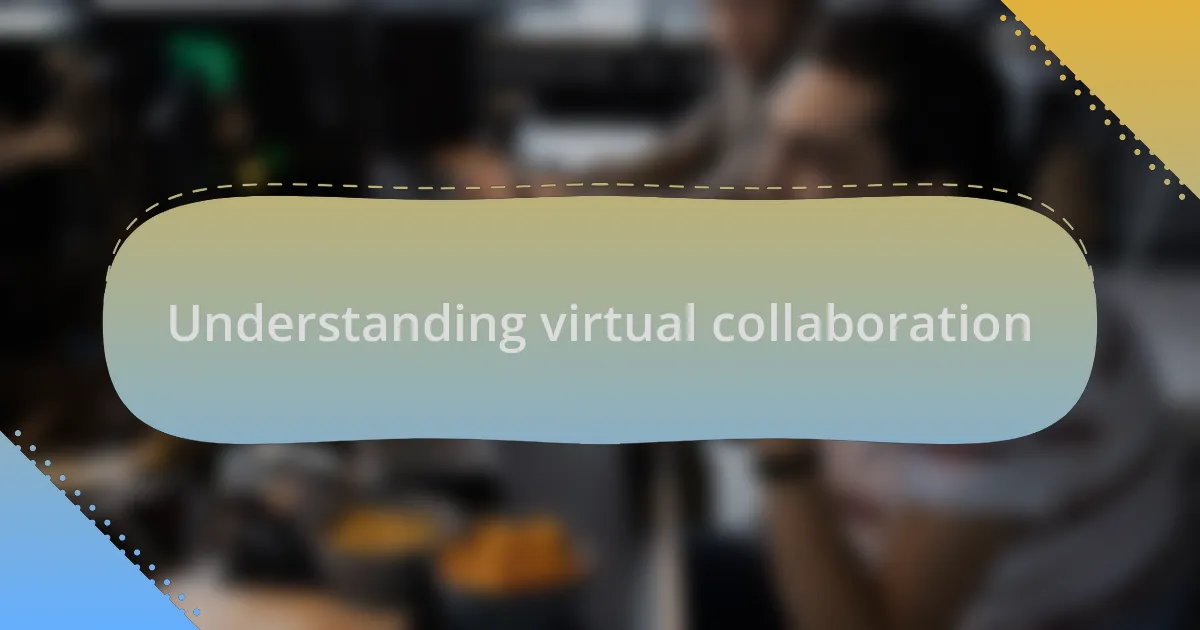
Understanding virtual collaboration
In today’s digital landscape, virtual collaboration has become a cornerstone of how we work and communicate. I remember the first time I joined an online coding project—there was this immediate sense of wonder mixed with a hint of skepticism. Could we actually build something meaningful without being in the same room? The answer, as I soon discovered, was a resounding yes; distance doesn’t diminish creativity or productivity if the right tools and attitudes are in place.
When I think about effective virtual collaboration, it often boils down to clear communication. In one of my projects, I experienced the frustration of misinterpretation due to vague messages in chat. It made me realize how critical it is to be explicit about ideas, expectations, and even deadlines. Have you ever faced a similar situation? From my own journey, I’ve learned that maintaining a consistent communication rhythm can prevent misunderstandings and foster teamwork, even when miles apart.
Another essential aspect is trust. Establishing trust in a virtual environment is not as straightforward as a friendly office chat over coffee. I recall a project where team members were hesitant to share their work due to fear of criticism. It taught me the importance of creating a supportive atmosphere. How can we encourage openness in virtual spaces? In my experience, celebrating small wins and openly acknowledging contributions can work wonders in building the camaraderie needed for successful collaboration.
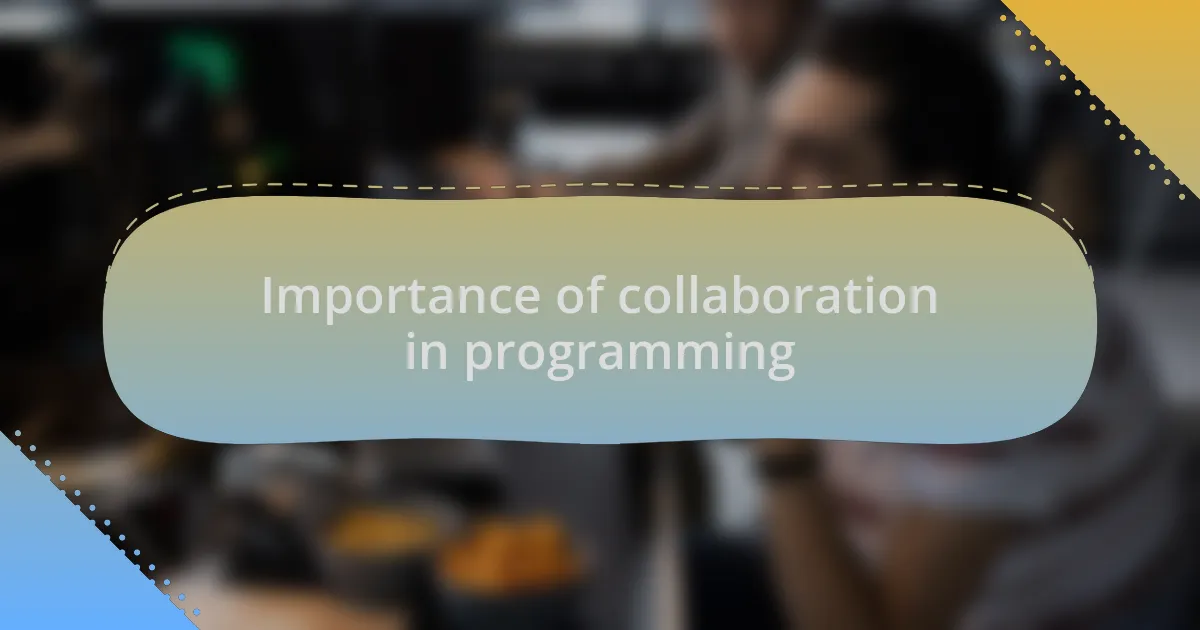
Importance of collaboration in programming
Collaboration in programming is essential because it brings together diverse perspectives and skill sets, sparking innovation and creativity. I’ve found that when I work with others, especially those with different backgrounds or expertise, I often discover solutions I wouldn’t have considered on my own. Have you ever had that moment when a teammate’s suggestion opens up a new avenue for solving a problem? It’s like unlocking a door to possibilities that were previously hidden.
Another thing to consider is how collaboration helps distribute the workload, preventing burnout. In one of my early programming collaborations, I tried to take on too much responsibility, thinking it would showcase my commitment. Instead, it led to stress and diminishing returns on my performance. Sharing tasks not only improved my productivity but also created a sense of camaraderie. Isn’t it reassuring to know that we can lean on each other during challenging times?
Finally, collaborating virtually allows for continuous learning. I remember joining an open-source project where I could interact with seasoned developers. Their feedback and guidance transformed my skills in ways I hadn’t anticipated. How often do we step out of our comfort zone and learn from others? This experience taught me that collaboration is not just about getting the job done; it’s an opportunity for personal growth and skill enhancement.
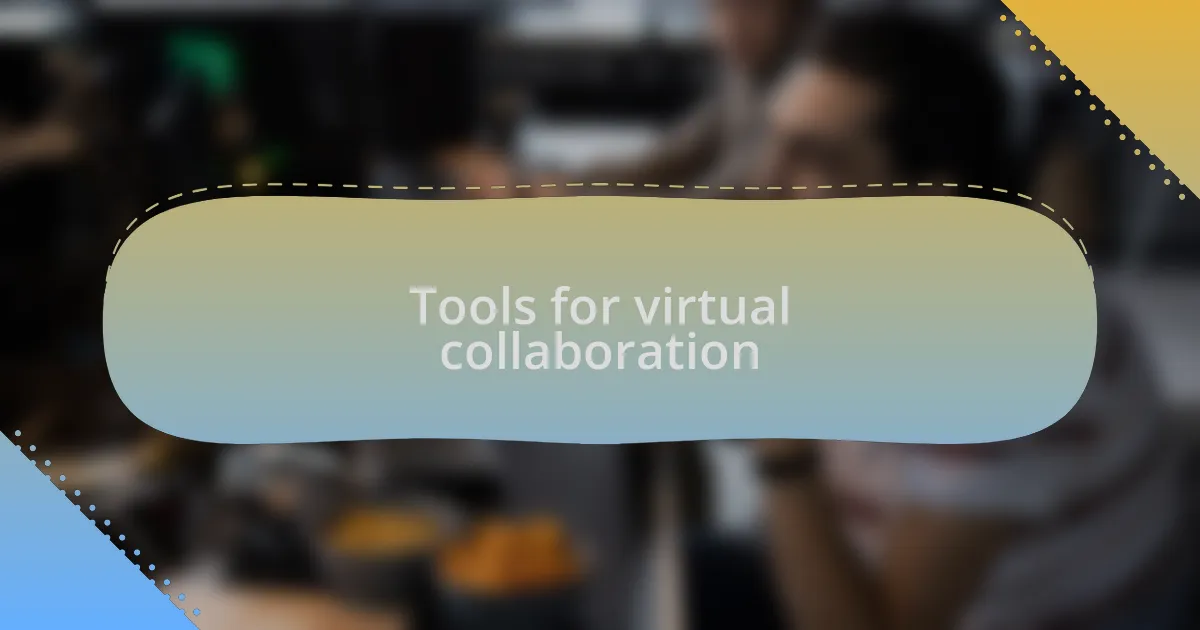
Tools for virtual collaboration
When it comes to tools for virtual collaboration, I’ve found that platforms like GitHub and GitLab are game changers. These tools not only allow for version control but also facilitate seamless communication among team members. I still remember my first pull request; it felt like a rite of passage, and receiving feedback in real-time opened my eyes to different coding practices. Have you ever felt that thrill of seeing your code being reviewed by peers? It’s a collaborative boost that encourages improvement.
Another favorite of mine is Slack. It streamlines communication with channels tailored for specific projects or teams, reducing the email overload. I recall a late-night coding session where a quick question asked in our Slack channel led to a breakthrough. One of my colleagues responded almost instantly, and his insight helped us move past a frustrating roadblock. Don’t you just love how immediate responses can spark a new train of thought?
Finally, tools like Visual Studio Live Share make coding in real time a breeze. I had an incredible experience where I paired with a developer in another country. We were both facing similar challenges, and being able to share our screens transformed our workflow. It’s almost magical how technology can bridge distances and create a sense of togetherness, don’t you think?
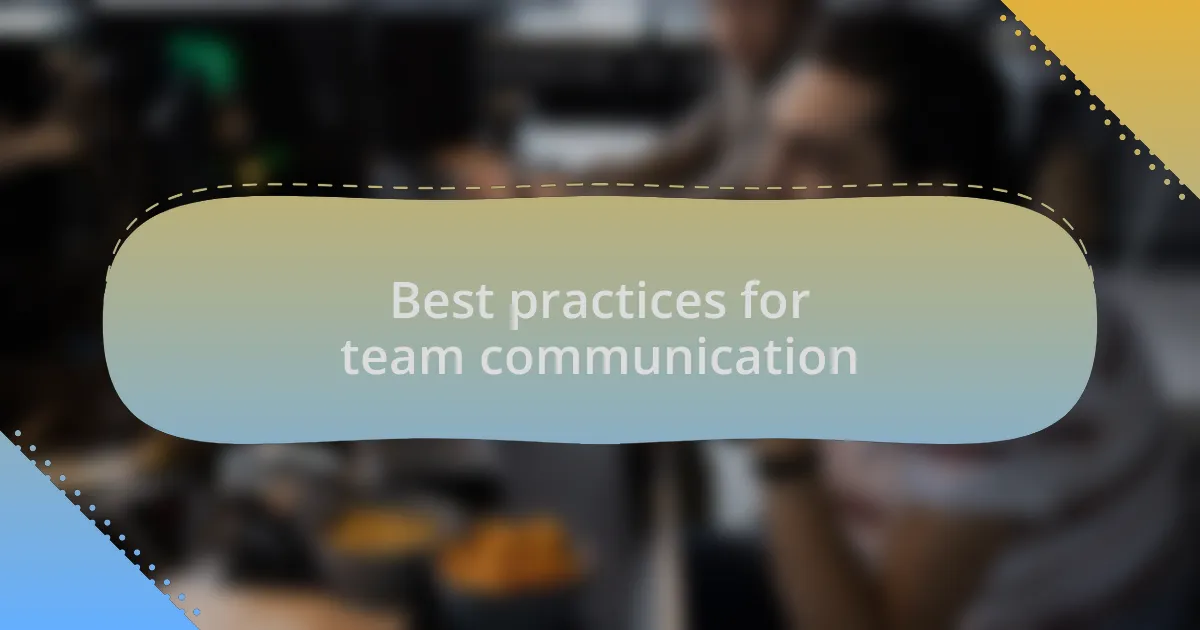
Best practices for team communication
Effective communication is the backbone of any successful team collaboration, especially in a virtual environment. I’ve found that establishing clear guidelines and expectations regarding communication channels can make a huge difference. For instance, I remember a project where we set specific times for updates and check-ins. This not only helped us stay on the same page but also fostered a sense of accountability. Have you ever felt the relief of knowing when to expect updates from teammates?
Moreover, utilizing video calls for more complex discussions is something I’ve grown to appreciate. During a challenging sprint, we faced a miscommunication issue that was dragging our timelines. When we switched to video calls, it felt far more personal, and we rapidly cleared up misunderstandings. There’s something about seeing facial expressions and hearing tone that can really transform the conversation. Don’t you prefer those face-to-face moments, even if they happen on a screen?
Lastly, I can’t stress enough the importance of feedback loops in virtual teams. I’ve been part of teams that lacked consistent feedback, and it often left me feeling disconnected and unsure of my contributions. By establishing a culture where constructive criticism is welcomed, we not only improve our projects but also build trust among team members. Have you experienced the shift when teammates become more open about sharing thoughts? It’s a game-changer!
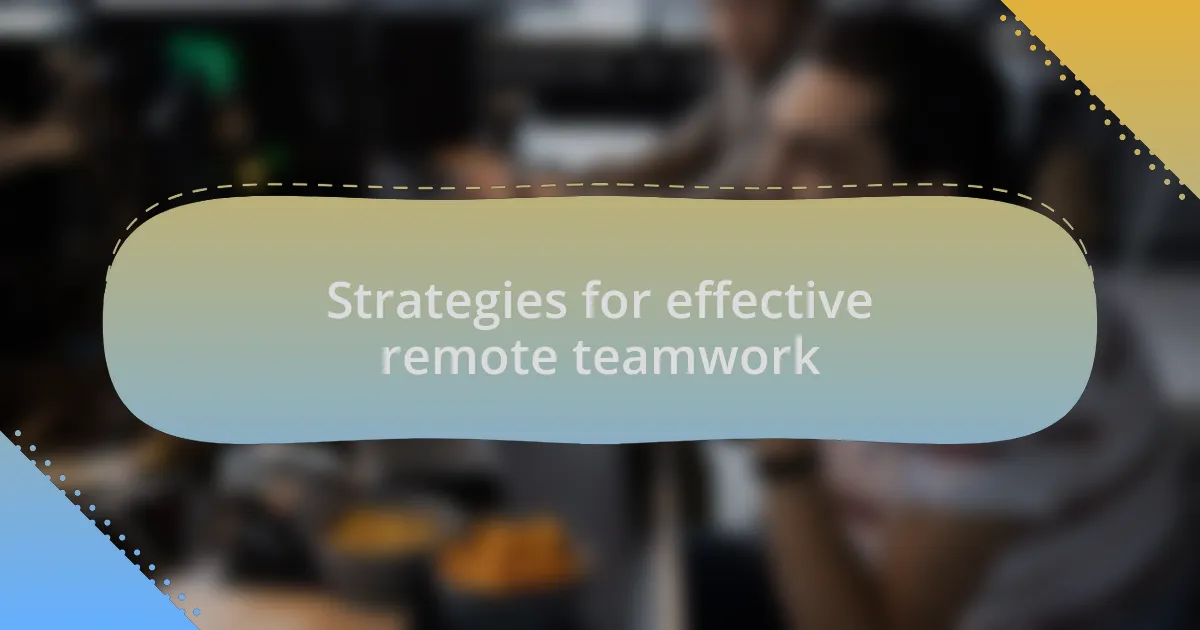
Strategies for effective remote teamwork
One strategy that has significantly improved my remote teamwork experience is the use of collaborative tools. For instance, our team once adopted a project management platform that allowed everyone to visualize tasks in real-time. Suddenly, it wasn’t just about sending updates; we could see our progress together. Have you ever noticed how satisfying it can be to tick off completed tasks? It fosters a sense of achievement and motivates the entire team.
Another approach I’ve found helpful is setting aside time for casual, non-work-related conversations. During our weekly meetings, we introduced a “water cooler” segment where team members share personal stories or interests. I distinctly remember a moment when a colleague opened up about their hobby of pottery. This seemingly small share sparked a deeper connection among us. Have you ever experienced a team bonding over shared interests? It makes working together feel less like a job and more like a supportive community.
Lastly, I believe that time zone awareness can’t be overlooked. During one international project, our team comprised members from three different continents. At first, scheduling meetings felt impossible, but when we started rotating meeting times to accommodate everyone, it demonstrated respect and understanding. I’ve seen the difference it makes when all voices feel valued and included—don’t you agree that inclusivity can drive collaboration to new heights?
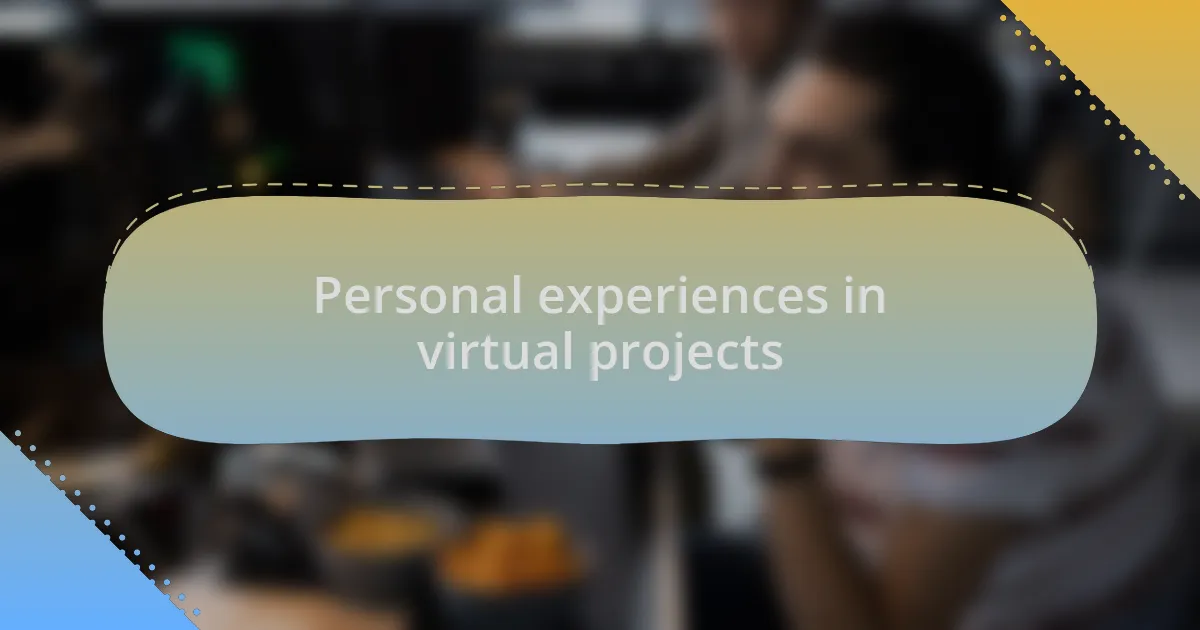
Personal experiences in virtual projects
In one of my virtual projects, I collaborated with a diverse group of developers spread across different time zones, which initially proved challenging. I vividly remember one late-night coding session where my teammate in India and I brainstormed solutions over chat while I sipped coffee. It felt like we were in the same room, bouncing ideas back and forth, fostering a sense of camaraderie despite the miles between us. Have you had a similar experience where distance seemed to vanish?
During another project, our team utilized video calls for pair programming sessions, and this not only enhanced our coding skills but built strong relationships. I recall working through a tough bug with a teammate in Brazil—I could almost feel the excitement when we finally cracked it, celebrating through our screens. Those moments of shared triumph remind me how collaboration can transform challenges into victories. Have you ever felt that rush of success with a remote colleague that made all the effort worthwhile?
One significant takeaway for me is the importance of celebrating small wins, even from afar. For instance, after completing a major milestone, we organized a virtual happy hour to unwind together. I was particularly touched when a quieter team member expressed gratitude for our support throughout the process. It made me realize that acknowledging achievements in a virtual space can really strengthen bonds. Don’t you think it’s vital to celebrate progress, no matter how big or small, to keep the spirit of teamwork alive?
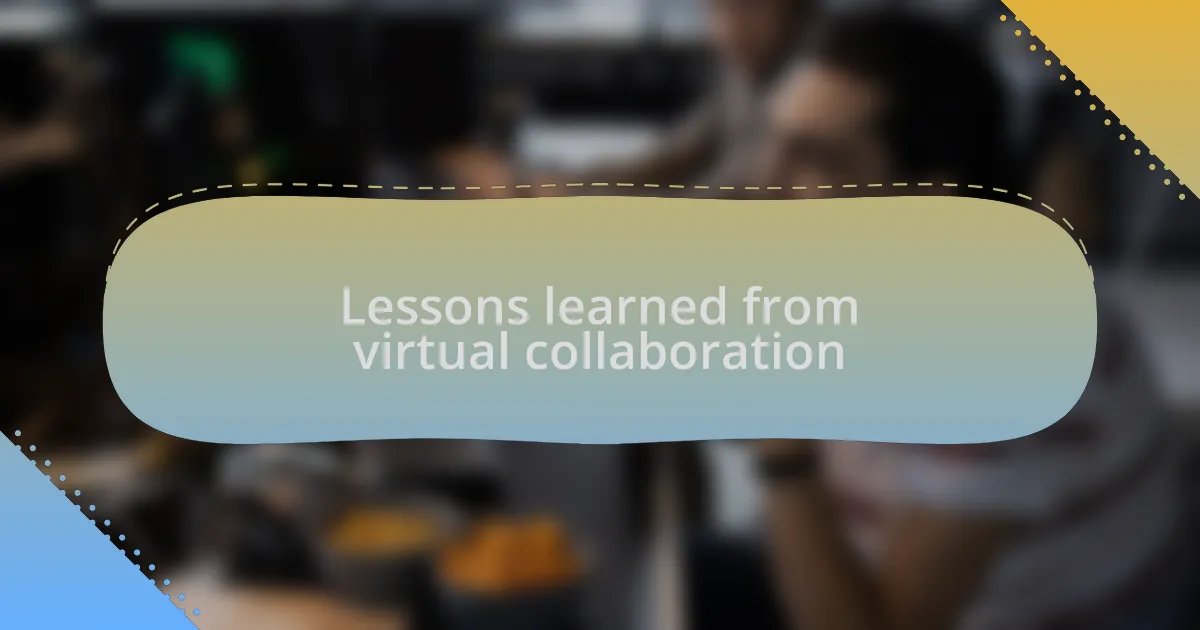
Lessons learned from virtual collaboration
One of the most profound lessons I’ve learned from virtual collaboration is the necessity of clear communication. During a project, I encountered a situation where a misunderstanding about a feature’s requirements led to a significant setback. It was frustrating! Reflecting on that experience, I now prioritize detailed discussions and follow-up messages to ensure everyone is on the same page. Have you ever faced a similar hiccup that could have been avoided with a bit more clarity?
Another key insight revolves around the value of flexibility. I remember a sprint where two teammates had to drop out last minute due to unexpected personal commitments. Instead of panicking, we adapted our plan, redistributed tasks, and kept momentum alive. It was a challenge that made me appreciate the necessity of being open to change. How do you handle unexpected shifts in your projects?
Finally, I’ve realized how crucial it is to create an inclusive environment, even virtually. One time, I encouraged quieter members to share their ideas in our brainstorming sessions by directly asking for their input. The result was eye-opening; it turned out they had fantastic suggestions that propelled our project forward. Have you noticed how fostering inclusivity can bring out the best in your team?